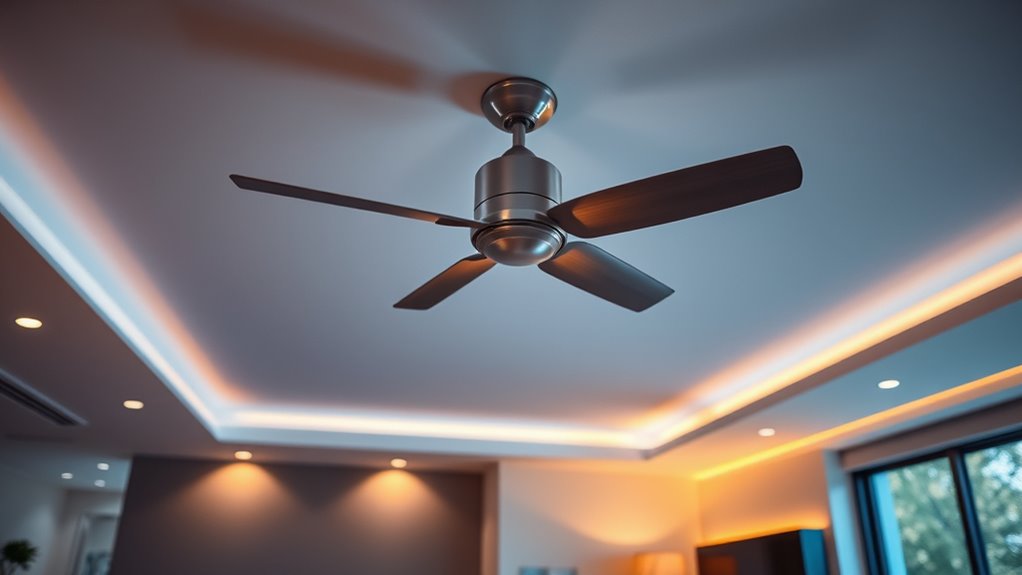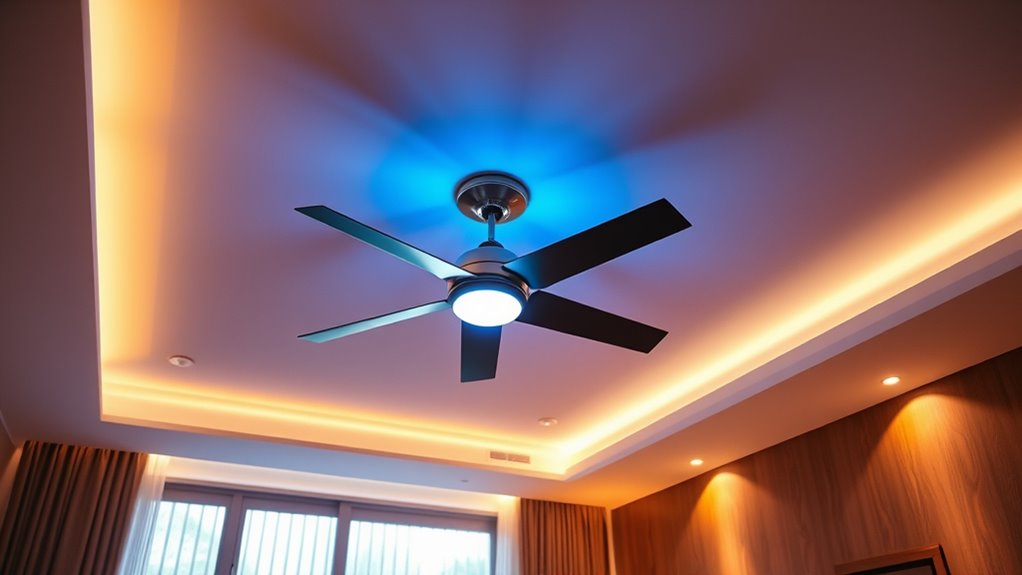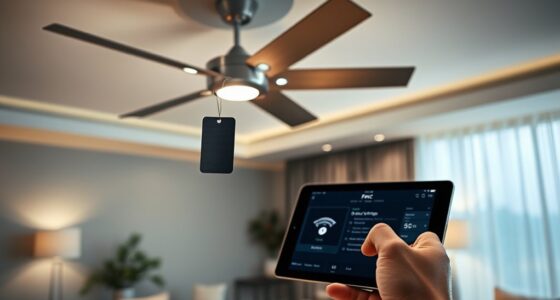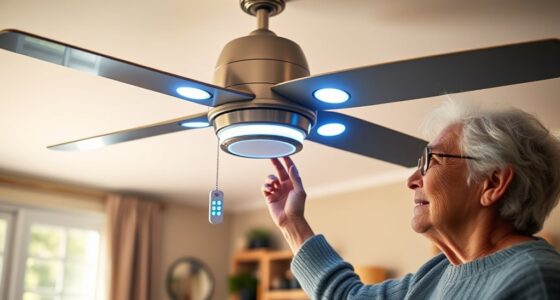To integrate smart ceiling fans with lighting scenes, ensure both devices are compatible with protocols like Zigbee, Z-Wave, or Wi-Fi, and connect them through a smart hub or platform such as Apple HomeKit, Google Home, or Amazon Alexa. Use scenes to group lighting and fan configurations, enabling synchronized control of brightness, color, and fan speed. Automate these scenes with sensors or schedules for enhanced convenience and energy efficiency. Exploring these integration methods provides a thorough understanding of seamless smart home automation.
Key Takeaways
- Use compatible smart home hubs or voice assistants to synchronize ceiling fan controls with lighting scenes.
- Create scenes that adjust both lighting settings and fan speeds or oscillation modes simultaneously.
- Group devices in your smart app to enable coordinated scene activation for fans and lights.
- Set automation rules triggered by environmental sensors to automatically adjust lighting and fan operation.
- Ensure strong network connectivity and updated firmware for reliable, seamless integration of fans and lighting scenes.

Integrating smart ceiling fans with smart lighting systems enhances both energy efficiency and user convenience by enabling centralized control and automation. This integration requires compatibility between the fan’s control mechanism and the lighting platform, often facilitated through protocols like Zigbee, Z-Wave, or Wi-Fi. To effectively synchronize fan and lighting operations, you’ll need a hub or controller that supports scene creation and device grouping, such as a smart home hub or a compatible voice assistant. This setup allows you to configure complex scenes where lighting and fan settings change simultaneously based on specific triggers or user commands.
From a technical standpoint, scene integration involves mapping control signals across devices. When a scene activates, the hub sends commands to the lighting fixtures—adjusting brightness, color temperature, or hue—and simultaneously toggles the fan’s speed or oscillation. This coordination demands that both devices support scene or automation features, which are often accessed via manufacturer-specific apps or universal home automation platforms like SmartThings, Home Assistant, or Apple HomeKit. Making sure that each device responds promptly and reliably is critical; latency or inconsistent responses can undermine the scene’s effectiveness and user experience.
Automation rules can further refine how scenes operate in response to environmental conditions. For example, you can set a “Movie Night” scene that dims the lights to a preferred level and reduces the fan speed to a whisper-quiet setting, creating an ideal viewing environment. Conversely, a “Wake Up” scene might gradually brighten the lights while increasing the fan speed for a revitalizing start to the day. These scene configurations often utilize sensors—such as motion detectors, ambient light sensors, or temperature sensors—to trigger automatic changes, reducing manual intervention and enhancing comfort.
To maximize scene effectiveness, you should pay attention to device settings and network stability. Ensure that firmware is up-to-date to support the latest scene features and that your Wi-Fi or Zigbee/Z-Wave network maintains strong signal integrity. Proper device placement minimizes latency and prevents communication failures. Additionally, consider the user interface—most smart home apps allow scene customization, but the process should be intuitive enough for you to modify or create new scenes easily as your preferences evolve. Reliable communication protocols are essential for seamless device coordination and responsiveness.
Ultimately, integrating smart ceiling fans with smart lighting scenes offers a highly customizable environment that aligns with your daily routines and preferences. By leveraging compatible hardware, robust automation rules, and reliable network infrastructure, you create a seamless, energy-efficient, and user-friendly smart home ecosystem that responds instantly to your commands and environmental cues.
Frequently Asked Questions
Can Smart Ceiling Fans Operate Without Wi-Fi?
Yes, some smart ceiling fans can operate without Wi-Fi if they have built-in Bluetooth or Zigbee connectivity for local control. These fans often include a physical remote or wall-mounted control panel, allowing you to adjust fan speed, oscillation, and lighting settings directly. However, for remote access, automation, or integration with smart home systems, a Wi-Fi connection is generally required. Always check the fan’s specifications to confirm its offline functionality.
Are Smart Fans Compatible With All Smart Lighting Brands?
Smart fans are not universally compatible with all smart lighting brands. Compatibility depends on the fan’s hub or control system, which often supports specific protocols like Zigbee, Z-Wave, or Wi-Fi. You need to verify that your smart lighting system and fan hub share the same protocol or are compatible with a common smart home platform, such as Alexa, Google Home, or Apple HomeKit. Check product specs for supported brands and protocols before integration.
How Secure Is the Integration of Smart Fans and Lighting?
Honestly, the integration’s security isn’t just a smooth ride; it’s a tightrope walk. While most systems use encryption protocols like WPA3 and TLS, vulnerabilities can still lurk in outdated firmware or weak passwords. You must keep your devices updated and use strong, unique passwords. Plus, enable two-factor authentication where possible. So, yes, it’s secure—if you stay vigilant and maintain your system diligently, avoiding the irony of a “secure” setup that’s actually exposed.
Can I Control Smart Fans Through Voice Assistants?
Yes, you can control smart fans through voice assistants like Alexa, Google Assistant, or Siri. These systems connect via Wi-Fi or Zigbee protocols, enabling voice commands for turning fans on or off, adjusting speed, and setting timers. Confirm your smart fan is compatible with your chosen voice assistant and correctly configured in its app. Proper integration allows seamless, hands-free control, enhancing convenience while maintaining security through encrypted communication.
What Is the Installation Process for Integrating Smart Fans and Lighting?
You start by turning off the power at the circuit breaker, then remove the existing fan and light fixture. For example, in a recent installation, a homeowner wired the smart fan’s control module into the existing switch box. Connect the fan’s wiring to the smart hub using the manufacturer’s wiring diagram, ensuring secure connections. Finally, turn the power back on, configure the devices via their app, and test the integration with your lighting scenes.
Conclusion
By seamlessly synchronizing smart ceiling fans with smart lighting scenes, you optimize ambiance and airflow, achieving a harmonious home environment. This integration enhances efficiency, elevates energy management, and empowers precise control over your space. When you combine consistent commands with customized settings, you create a cohesive, connected climate that responds intuitively to your needs. Ultimately, this synchronized system simplifies smart home management, strengthening your space’s sophistication and ensuring sustained comfort through strategic, smart synchronization.









